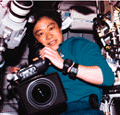 |
 |
 |
|
Worldwide
Announcement of Research
and Development Results Katsuji
EBISAWA, President
of NHK Katsuji
EBISAWA, President
of NHKThis year, the year 2000, is the 75th anniversary of the first broadcast in Japan. The progress of digital technology has brought the broadcasting world to a significant turning point in its history. Digital satellite broadcasting services are to commence in December this year, and experimental digital terrestrial television broadcasts have been promoted throughout the country. It is HDTV, with its high quality picture, that will shoulder the burden of the digital age. NHK started research on HDTV in 1964, when the Tokyo Olympics were held. The development of HDTV is now moving forward worldwide and universally; in 1998, the U.S. space shuttle Discovery sent a clear picture from space with an HDTV camera, when one of the astronauts, Mukai Chiaki, used it to film images outside the spacecraft. Dynamic live relays of Mother Nature from the Grand Canyon and Monument Valley were also carried out last year. In May of last year, the many years of research and effort finally bloomed in success at the meeting of the ITU(International Telecommunication Union), with the adoption of NHK's Hi-Vision as the international production standard of HDTV. Leading the world, we will promote an experimental digital HDTV service in July of this year, using both satellite and terrestrial services, at the Okinawa Summit. It is our hope again to draw international attention to NHK's outstanding technical ability at an occasion where many of the world's leaders and news media will be convening.
My wish is for these research and development results and technologies to be plainly announced, proclaiming worldwide the worth of NHK as a public broadcaster. I sincerely hope that this "Broadcast Technology" will help to further the mission of NHK. |
|
||||||||
|
| |||||||||
|
|||||||||
| Back Number | ||||
| I For the Inaugural Issue I Features I Symposium I About us I Treatise I Invention I Topics I R & D I From Divisions I NHK CG Technology I From the Editors I | ||||
Copyright 2000 NHK (Japan Broadcasting Corporation) All rights reserved. Unauthorized copy of the pages is prohibited.
 |
| NHK STRL |



